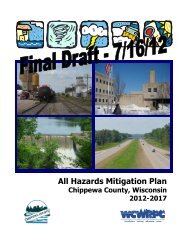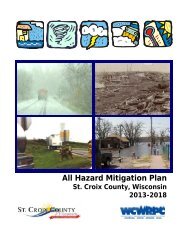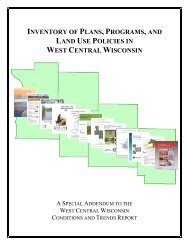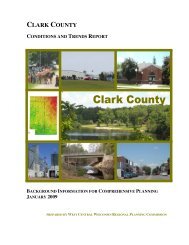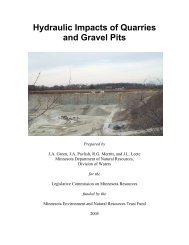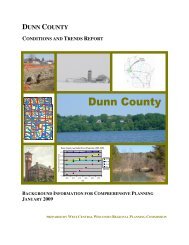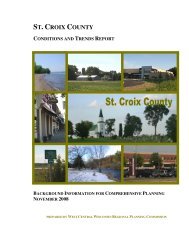The Economic Impacts of Alaska's Mining Industry - Alaska Miners ...
The Economic Impacts of Alaska's Mining Industry - Alaska Miners ...
The Economic Impacts of Alaska's Mining Industry - Alaska Miners ...
You also want an ePaper? Increase the reach of your titles
YUMPU automatically turns print PDFs into web optimized ePapers that Google loves.
more than 500 placer mines statewide (including<br />
recreational mines) producing 174,900 ounces <strong>of</strong><br />
gold worth $70 million. 22<br />
<strong>The</strong> fluctuation <strong>of</strong> gold prices continues to affect<br />
the level <strong>of</strong> gold placer production in <strong>Alaska</strong>. For<br />
instance, gold prices saw a marked improvement<br />
in the late 70s peaking at over $800 per ounce in<br />
1980, followed by a gradual but fluctuating decline<br />
to $256 per ounce in 2001. With the fall in prices,<br />
the number <strong>of</strong> operating mines dropped to 42. <strong>The</strong><br />
price has been improving since that date with<br />
recent prices above $550 per ounce. By 2004,<br />
there were 68 <strong>Alaska</strong> placer mines recovering<br />
28,074 ounces <strong>of</strong> gold.<br />
Rock production in <strong>Alaska</strong> in 2004 was estimated<br />
to be 7.3 million tons. This includes shot rock,<br />
crushed stone, D-1, riprap, and modest quantities<br />
<strong>of</strong> ornamental stone. With an estimated unit value<br />
<strong>of</strong> $14.51 per ton, the total value was estimated to<br />
be $106 million in 2004.<br />
Annual rock, sand and gravel production is <strong>of</strong>ten a<br />
reflection <strong>of</strong> trends within the construction market.<br />
For example, production dipped in the mid-1980s<br />
and mid-1990s, and peaked in late 1990s,<br />
reflecting booms and declines in <strong>Alaska</strong>’s housing,<br />
industrial and commercial construction markets.<br />
Coal<br />
Most <strong>of</strong> the state’s active placer mines are located<br />
in the Interior. <strong>The</strong> three largest placer mines<br />
accounted for over half <strong>of</strong> all placer production.<br />
<strong>Alaska</strong>’s Non-Metal Mines<br />
Rock, Sand and Gravel<br />
Rock, sand and gravel deposits<br />
are being mined in most <strong>Alaska</strong><br />
communities, supporting road,<br />
air strip, and other commercial,<br />
industrial, and residential<br />
construction projects throughout<br />
<strong>Alaska</strong>. Some <strong>of</strong> the operations<br />
are quite small, ranging from<br />
small gravel pits serving village<br />
communities to large quarries and gravel pits<br />
found closer to the larger population centers along<br />
the <strong>Alaska</strong> Railbelt. For instance, some <strong>of</strong> the<br />
larger gravel pit operations are found in<br />
Anchorage, Palmer, Wasilla, and Fairbanks.<br />
According to the <strong>Alaska</strong> Department <strong>of</strong><br />
Commerce, Community and <strong>Economic</strong><br />
Development, there are 37 rock quarries and 71<br />
sand and gravel operations within <strong>Alaska</strong>. It is<br />
difficult, however, to know if this count is complete<br />
as many <strong>of</strong> the operations are small, unregulated,<br />
and infrequently operated. In 2004, approximately<br />
20 million tons <strong>of</strong> sand and gravel were produced<br />
in <strong>Alaska</strong>. With an estimated average value <strong>of</strong><br />
$5.19 per ton, the total value <strong>of</strong> this sand and<br />
gravel was $101 million.<br />
<strong>The</strong> Usibelli Coal Mine is the only operating coal<br />
mine in <strong>Alaska</strong>. <strong>The</strong> mine is located near Healy<br />
and has 200 million tons <strong>of</strong> proven coal reserves.<br />
In 2004, coal production totaled 1,450,000 tons,<br />
about half <strong>of</strong> which was shipped to six Interior<br />
<strong>Alaska</strong> electrical<br />
generation power<br />
plants. Approximately<br />
601,000 tons were<br />
exported to South<br />
Korea through a<br />
terminal in Seward,<br />
and two test shipments<br />
totaling 105,000 tons<br />
were made to Chile.<br />
Rail shipment <strong>of</strong> coal<br />
is an important source<br />
<strong>of</strong> revenue for the <strong>Alaska</strong> Railroad (ARR). Coal<br />
accounted for $10 million in revenues for ARR in<br />
FY 2004.<br />
Coal has the potential to play a much greater<br />
role in the <strong>Alaska</strong> economy. <strong>Alaska</strong> coal<br />
reserves total approximately 174 billion tons,<br />
40 percent <strong>of</strong> the U.S. total. Plans for a coal<br />
gasification plant on the Kenai Peninsula to<br />
supply Agrium’s ammonia and urea<br />
production facility could increase the<br />
importance <strong>of</strong> coal in the <strong>Alaska</strong> economy in<br />
the near term.<br />
22<br />
Ibid.<br />
<strong>The</strong> <strong>Economic</strong> <strong>Impacts</strong> <strong>of</strong> <strong>Alaska</strong>’s <strong>Mining</strong> <strong>Industry</strong> McDowell Group, Inc. • Page 16



